15 DIY Plywood Desk Plans to Make (original) (raw)
Making a DIY plywood desk can offer a personalized touch to your workspace while being a fun and rewarding project. These 15 free DIY plywood desk plans cover everything from choosing the right materials and tools to adding unique finishes and solving common problems. Whether you're aiming to craft a simple, functional piece or aiming to inject your personality into your work environment, understanding the basics of plywood, choosing the right tools, and embracing customization are key steps to success.
With sections including how to navigate the selection of plywood types and grades, to the detailed walkthroughs on assembly and customization, this guide is a comprehensive resource for anyone ready to tackle their project. Practical advice on maintenance and dealing with issues like warping or splintering ensures your DIY desk remains sturdy and attractive over time.
Get ready to dive into the process, equipped with the knowledge to make a desk that meets your needs and reflects your style. Continue reading to learn more about turning plywood into your new favorite workspace.
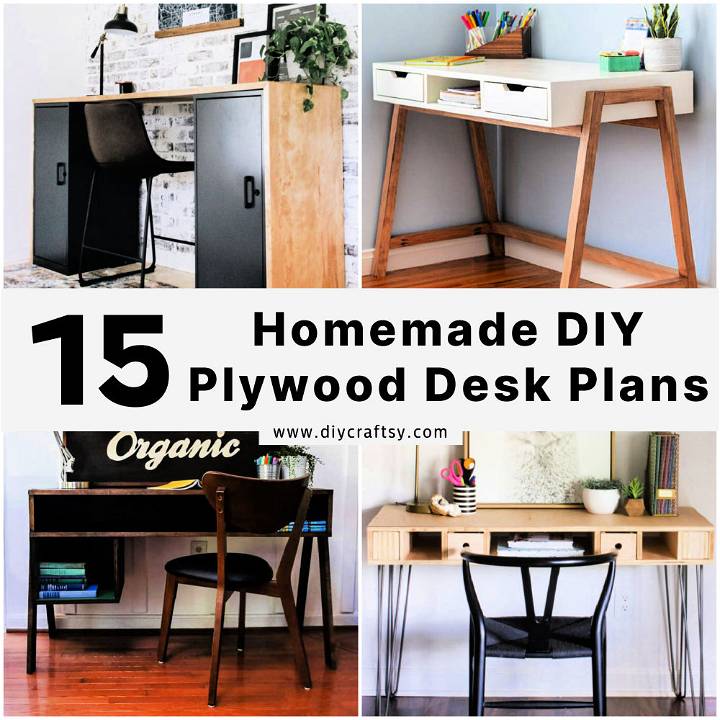
How to Build a Plywood Desk - Step by Step
Making a simple, elegant plywood desk doesn't have to be a daunting task. You only need three basic power tools and a bit of creativity. This desk features a beautifully curved plywood shelf that is perfect for a laptop, using a method known as kerf bending. Here's your step-by-step guide to making this functional piece of furniture for your home or office.
Materials and Tools Required
- 3/4 inch thick birch veneer furniture grade plywood for the desktop
- Quarter-inch plywood for the curved shelf
- Pre-fabricated steel legs
- Spring clamps
- Circular saw
- Speed square
- Wood glue
- Wood putty
- Orbital sander with 100, 150, and 220 grit sandpaper
- Sanding sponge
- Clean rags
- Maker Brand simple finish (or equivalent wood finish)
Preparation
- Cut the Desktop: Begin by using your circular saw, guided by a straight edge clamped down, to cut your 3/4 inch birch plywood to the desired dimensions of your desktop.
- Speed Square Cuts: For cross cuts, use a speed square to draw a line on the plywood, then follow the line with your circular saw.
Making the Curved Shelf
- Cut Additional Layers: Cut two pieces of quarter-inch plywood to the same width as the desktop, but leave them slightly longer for adjustments later. These will form the curved shelf.
- Mark for Kerf Bends: Decide where your shelf will curve. Mark a middle section approximately 16 inches wide on your quarter-inch plywood. Then, mark an additional eight inches on either side of this section.
- The score for Kerf Bending: Within the eight-inch sections, cut score lines halfway through the plywood about every half inch. Adjust your circular saw's depth accordingly to avoid cutting all the way through.
- Apply Glue: Situate a 16-inch wide piece of three-quarter-inch plywood beneath your scored pieces. Apply wood glue between the score marks and clamp the quarter-inch plywood down to this base, following the curve you desire.
- Clamping: Use spring clamps to secure the edges and ensure good adhesion between the sheets of plywood.
- Trim and Glue Again: Trim any excess from the overlapped quarter-inch plywood for a neat finish. Apply a generous coat of glue on top of the first quarter-inch sheet, spreading evenly. Place the second quarter-inch sheet (score marks facing down) on top and clamp together.
Finishing Touches
- Final Trims: Once the glue has cured, remove the clamps and trim the edges to ensure they're flush with the desktop.
- Sanding: Sand the edges and surface, starting with 100 grit, progressing to 150, and finishing with 220 grit sandpaper for a smooth finish.
- Attach Legs: Prepare your pre-fabricated steel legs as per the manufacturer's instructions and secure them to the underside of your desk.
- Finish Application: Fill any gaps with wood putty, sand once more if necessary, then clean off the dust. Apply your choice of wood finish, ensuring an even coat and a consistent result.
Video Tutorial
For a step-by-step video tutorial, watch this YouTube video.
It pairs well with this written guide, illuminating the techniques discussed with a clear and approachable visual demonstration.
With patience and precision, you've now created a stunning and durable plywood desk, perfect for modern workspaces or home offices. It's a rewarding project that demonstrates the versatility of plywood and the power of simple tools.
Material Selection: Choosing the Right Plywood for Your Desk
Selecting the right plywood is a critical step in making a durable and aesthetically pleasing DIY desk. Here's a guide to help you make an informed decision.
Types of Plywood
- Softwood Plywood: Generally less expensive, suitable for utility purposes.
- Hardwood Plywood: More durable and comes in varieties like oak, maple, and birch.
- Marine Plywood: Water-resistant, ideal for desks that might be exposed to moisture.
Plywood Grades
- Grade A: Smooth, paintable surface with minimal defects.
- Grade B: Minor blemishes that can be easily sanded or patched.
- Grade C & D: More knots and defects, suitable for parts of the desk that won't be visible.
Thickness Matters
- 1/2 Inch Plywood: Good for lightweight desks with minimal load.
- 3/4 Inch Plywood: Best for most desk projects, offering a balance of strength and weight.
Consider the Core
- Veneer Core: Made of alternating layers of hardwood, it offers strength and stability.
- MDF Core: Provides a smooth finish but is heavier and less resistant to moisture.
By understanding these aspects of plywood, you can choose the material that best suits your desk's design and functionality. The right plywood will not only support your work but also reflect your personal style.
Customization Ideas for Your DIY Plywood Desk
Making a DIY plywood desk is not just about building a functional piece of furniture; it's about crafting a workspace that reflects your personal style and meets your specific needs. Here are some creative ways to add a personal touch to your desk:
Choose Your Desk Shape
- Straight Desk: A classic choice that fits well in most spaces.
- L-Shaped Desk: Ideal for corner spaces and provides ample surface area.
- Floating Desk: Mounted to the wall, it saves floor space and creates a clean look.
Add Functional Features
- Cable Management: Install grommets or a cable tray to keep wires tidy.
- Adjustable Height: Incorporate lift mechanisms for a sit-stand desk option.
- Built-In Storage: Add drawers or shelves underneath for organization.
Personalize with Finishes
- Paint: Brighten up your desk with a color that inspires you.
- Stain: Highlight the natural beauty of the wood with a stain that complements your decor.
- Laminate: Apply a laminate top for a durable and easy-to-clean surface.
Decorative Touches
- Edge Banding: Use contrasting colors or materials for a unique edge detail.
- Inlays: Incorporate a design or pattern with different wood species or materials.
- Hardware: Select drawer pulls or knobs that match your style.
By considering these customization ideas, you can make a desk that not only serves its purpose but also becomes a centerpiece in your home or office. Remember, the key to a successful DIY project is to have fun and let your creativity shine!
Tools and Safety for Building Your DIY Plywood Desk
When embarking on your DIY plywood desk project, it's essential to prioritize safety and use the right tools. This section will guide you through selecting appropriate tools and adhering to safety protocols to ensure a smooth and secure building process.
Selecting the Right Tools
- Measuring Tape: Accurately measure your materials.
- Circular Saw: For straight cuts on plywood sheets.
- Drill: To assemble parts with screws.
- Sandpaper: Smooth out rough edges.
Safety First
- Wear Protective Gear: Always use safety glasses, gloves, and ear protection.
- Work in a Ventilated Area: Ensure proper airflow, especially when sanding or painting.
- Keep a Clean Workspace: Organize tools and materials to prevent accidents.
Using Tools Correctly
- Read Manuals: Understand how to operate each tool safely.
- Secure Materials: Clamp down plywood when cutting or drilling.
- Check Equipment: Inspect tools for damage before use.
By following these guidelines, you'll make a safe environment for your DIY project. Remember, taking the time to prepare and focus on safety will not only protect you but also result in a better-crafted desk.
Troubleshooting Common Issues with DIY Plywood Desks
When crafting a DIY plywood desk, you might encounter a few hiccups along the way. Don't worry; it's all part of the DIY experience! Here's a helpful guide to troubleshoot common issues:
Dealing with Warped Plywood
- Identify the Warp: Place the plywood on a flat surface to see where it lifts.
- Flatten the Plywood: Use weights or clamps to gently flatten the board over time.
Fixing Splintered Edges
- Sand the Edges: Gently sand down splinters with fine-grit sandpaper.
- Seal the Edges: Apply edge banding or a sealant to protect and smooth the edges.
Strengthening Weak Joints
- Check the Joints: Ensure all screws and joints are tight and well-aligned.
- Add Reinforcements: Use corner brackets or additional screws for extra stability.
Eliminating Squeaks and Wobbles
- Level the Legs: Adjust the length of the legs or add shims to stabilize the desk.
- Secure Connections: Tighten all hardware and ensure the desk is assembled correctly.
By being prepared to tackle these common issues, you'll be well on your way to making a sturdy and reliable DIY plywood desk.
Maintenance Tips for Your DIY Plywood Desk
Ensuring your DIY plywood desk remains in top condition requires regular maintenance. Here are some straightforward tips to help you keep your desk looking great and functioning well for years to come.
Protecting the Surface
- Use Coasters: Prevent water rings and stains by using coasters under beverages.
- Desk Pad: Consider a desk pad to protect the surface from scratches and wear.
Cleaning Your Desk
- Dust Regularly: Wipe the surface with a soft, dry cloth to remove dust.
- Gentle Cleaning: For spills, use a damp cloth with mild soap, then dry immediately.
Periodic Check-ups
- Tighten Fittings: Every few months, check and tighten screws and joints.
- Inspect for Damage: Look for any signs of wear or damage and address them promptly.
By following these simple maintenance steps, you can ensure that your DIY plywood desk remains a durable and stylish part of your workspace.
Understanding the Environmental Impact of Plywood
When making a DIY plywood desk, it's important to consider the environmental impact of your materials. This section will help you understand the sustainability of plywood and how to make eco-friendly choices.
What is Plywood?
Plywood is a versatile engineered wood made from thin layers, or “plies,” of wood veneer glued together. It's known for its strength and durability.
The Sustainability of Plywood
- Sourced Responsibly: Look for plywood certified by the Forest Stewardship Council (FSC) to ensure it comes from responsibly managed forests.
- Recycled Options: Some plywood is made from recycled wood, reducing the need for new timber.
- Durability: Plywood's longevity means less frequent replacement and less waste.
Minimizing Environmental Impact
- Buy Local: Reduce carbon footprint by purchasing plywood from local suppliers.
- Proper Disposal: Recycle or repurpose offcuts to minimize landfill waste.
- Eco-Friendly Finishes: Choose water-based finishes or natural oils that are less harmful to the environment.
By making informed choices about the materials and methods you use for your DIY plywood desk, you can contribute to a healthier planet.
Budgeting and Cost Analysis for Your DIY Plywood Desk
Making a budget for your DIY plywood desk is crucial to ensure that you can complete your project without financial stress. Here's a guide to help you understand the costs involved and how to manage them effectively.
Estimating Material Costs
- Plywood: The price varies based on the type and thickness. Expect to pay more for higher-quality or specialty plywood.
- Hardware: Screws, brackets, and drawer slides add to the cost but are essential for a sturdy build.
- Finishes: Paint, stain, or sealant will protect your desk and enhance its appearance.
Tools and Equipment
- Borrow or Rent: Save money by borrowing tools from friends or renting them.
- Invest in Quality: If you buy tools, choose quality ones that will last for future projects.
Labor Costs
- DIY Saves Money: By doing the work yourself, you save on labor costs.
- Value Your Time: Consider the time investment as part of your budget.
Unexpected Expenses
- Contingency Fund: Set aside an extra 10-15% of your budget for unexpected costs.
- Sales and Discounts: Look out for sales on materials and tools to reduce expenses.
By planning your budget and costs, you can make a DIY plywood desk economically.
FAQs for DIY Plywood Desk Projects
When undertaking a DIY plywood desk project, you may have questions. This FAQ section aims to address common queries to help you navigate your project with confidence.
What type of plywood is best for a desk?
A: Look for birch or maple plywood for their smooth finish and strength. Ensure it's at least 3/4 inch thick for durability.
How can I prevent the plywood from warping?
A: Store your plywood flat and avoid exposure to moisture. Use a thicker sheet and proper support to minimize warping.
Can I make a desk without power tools?
A: Yes, but it's more challenging. Hand saws, screwdrivers, and manual drills can substitute, but power tools save time and effort.
How do I protect the surface of my desk?
A: Apply a clear polyurethane coat for protection. You can also use linseed oil for a natural finish.
What's the best way to cut plywood?
A: Use a circular saw with a fine-tooth blade for straight cuts. Support the plywood on a stable surface to prevent splintering.
By answering these questions clearly, you'll prepare readers for their DIY desk project, making the process smoother.
Discover the best 15 free DIY plywood desk plans to create your own stylish and functional workspace at home.
1. Building a Plywood Desk - Step by Step
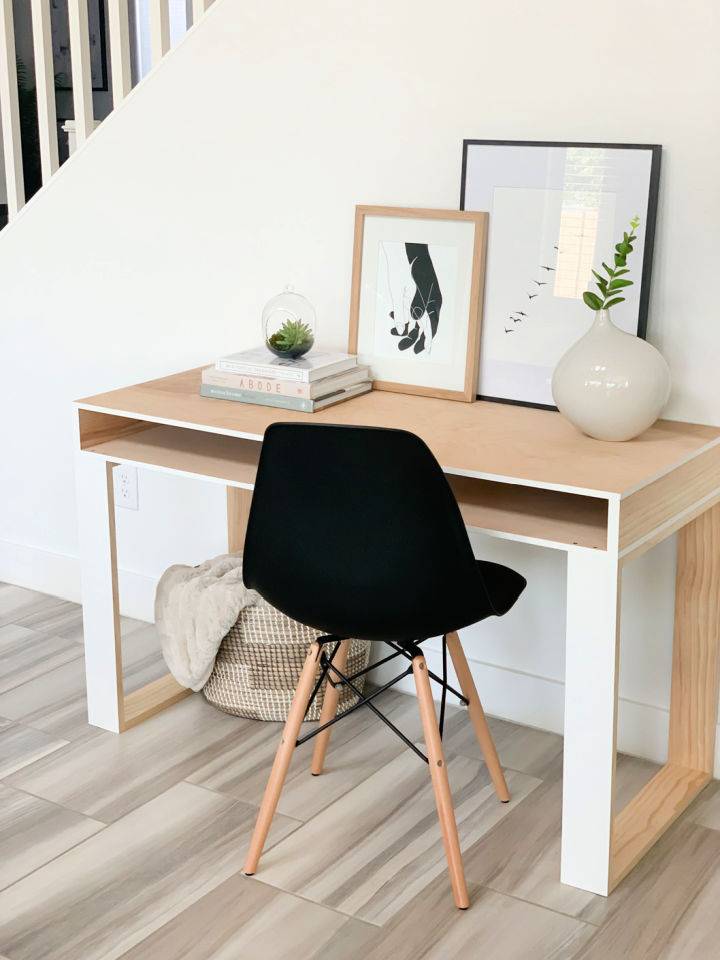
Build your own simple and affordable DIY desk with this easy guide from Neatly Living. Discover how with just a few materials and some creative flair, you can assemble a functional and stylish workspace. This project is perfect for those in need of a desk solution that doesn't break the bank or require expert carpentry skills. Ideal for students, remote workers, or anyone looking to add a personal touch to their living space.
2. How to Make a Plywood Desk
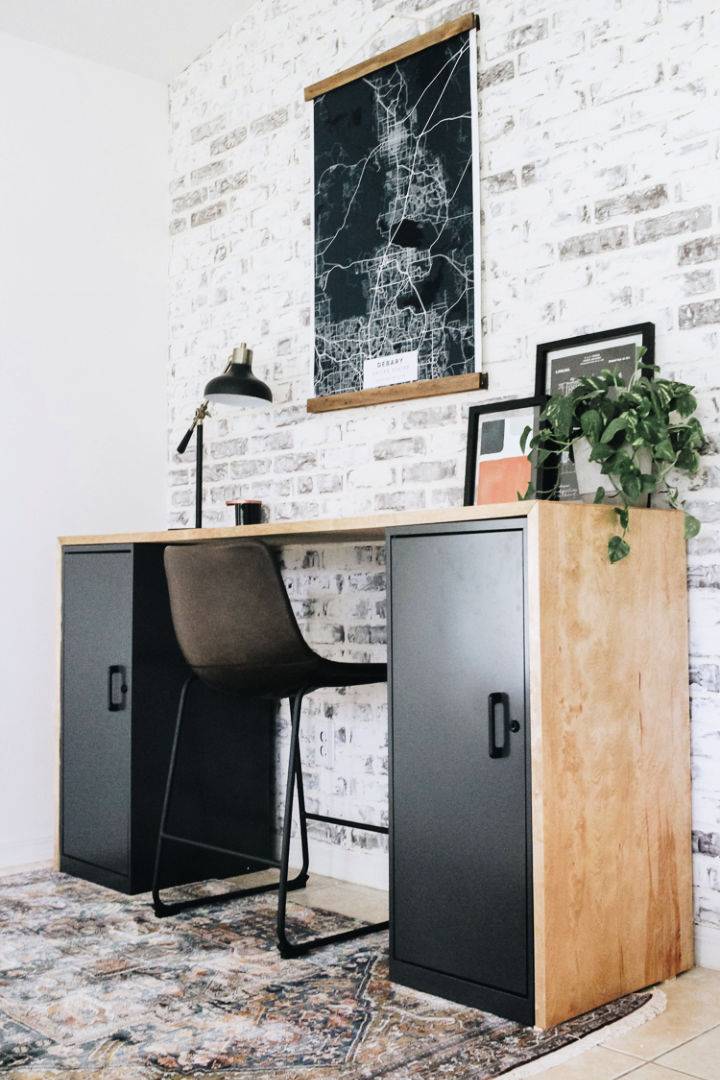
Transform your workspace with a stylish and affordable DIY plywood desk, featuring a sleek waterfall edge, with guidance. Within the Grove offers a step-by-step tutorial on how to craft a stunning desk from plywood, a material praised for its lightweight nature, ease of use, and cost-effectiveness.
Emphasis is placed on utilizing birch plywood for its beautiful woodgrain finish. The project's total cost is around $75, significantly lower than buying a similar desk. This tutorial highlights the materials and tools required, ensuring you achieve a professional and durable result, turning your office space into a statement area while sticking to a budget.
3. Modern DIY Plywood Desk with Hairpin Legs
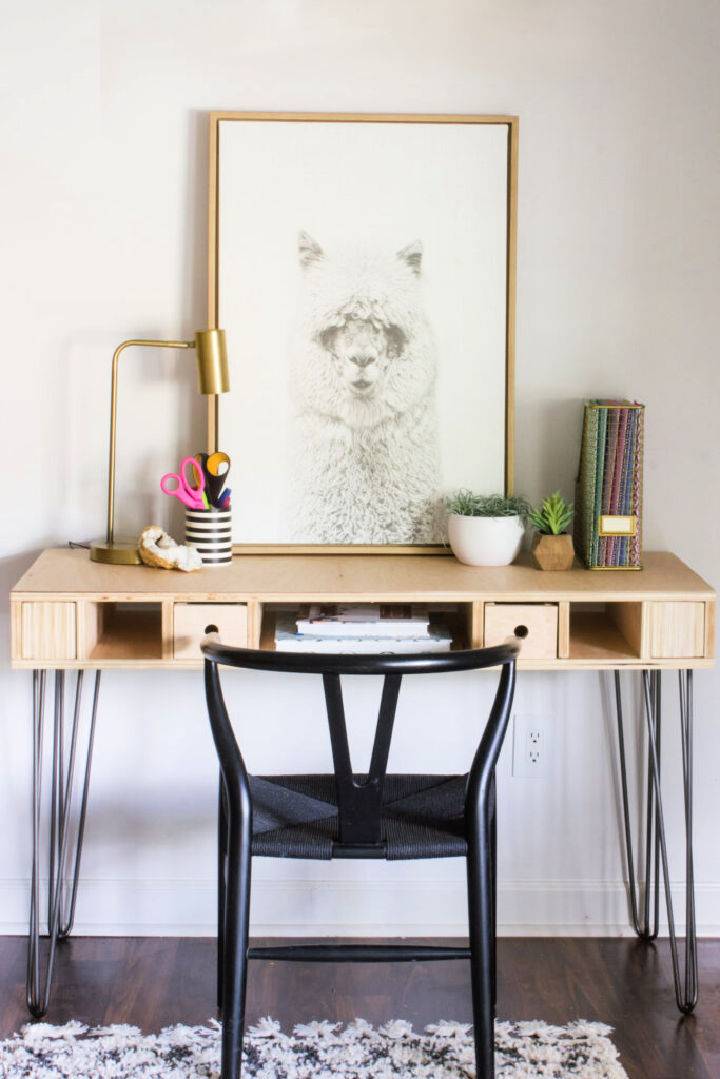
Start building your very own stylish and functional DIY plywood desk with sleek hairpin legs, following Erin Spain's detailed guide. This unique creation not only brings a minimalist charm to your workspace but incorporates clever storage solutions with magnetic pop-out bins.
Ideal for organizing supplies without sacrificing design, this project suits anyone looking to enhance their home office or study area. From selecting the right plywood to attaching the trendy hairpin legs, every step is clearly laid out to ensure a smooth building process. For a comprehensive walkthrough, visit Erin Spain. Transform your workspace today with this engaging, easy-to-follow DIY task.
4. Simple DIY One Plywood Sheet Desk
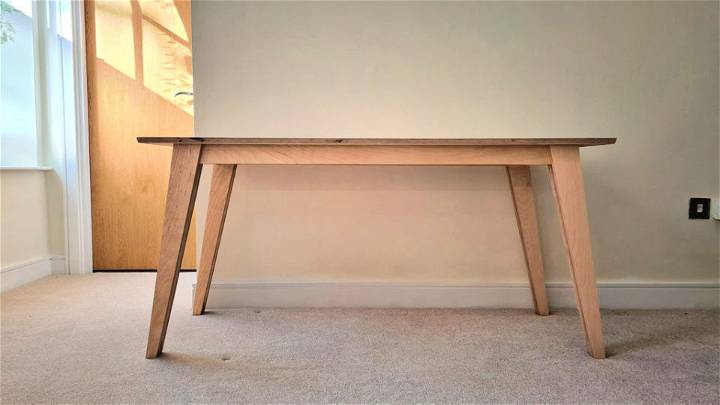
Construct your own modern and sleek DIY desk with a single sheet of plywood and some basic tools. A perfect project for those looking to add a personal touch to their workspace without breaking the bank. This DIY venture is beginner-friendly and can be undertaken right in your living room.
The process involves simple steps from cutting to assembling, ensuring you end up with a sturdy and stylish desk. For a detailed guide and visuals to kick-start your project, visit Instructables. Ready to enhance your space? Grab your tools and let's make something great!
5. How to Build a Desk with One Sheet of Plywood
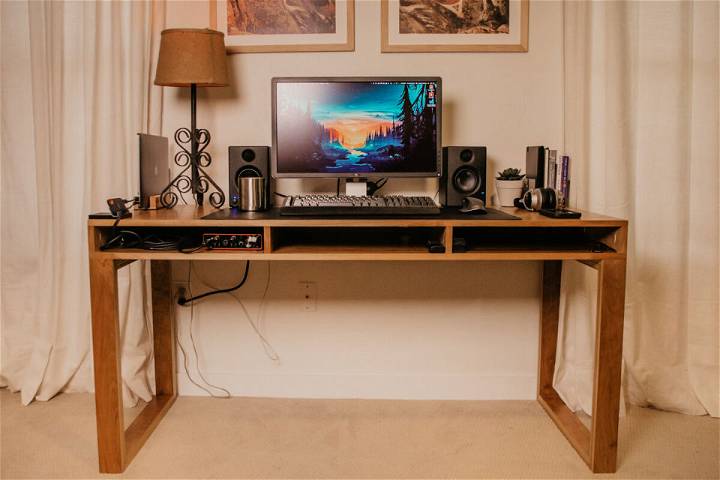
Upgrade your workspace with this streamlined, easy-to-follow guide on crafting a splendid DIY plywood desk using only one sheet of plywood! With WOODBREW's insights, this manageable project entails minimal tools and offers step-by-step instructions on making cuts, drilling pocket holes, and assembly details for making a desk equipped with convenient cubbies and sleek legs.
Plus, discover expert tips on adding a computer cord slot for a clutter-free setup and the finishing touches that elevate the desk's durability and aesthetic appeal. Dive right into building a functional, stylish desk that champions simplicity and organizational excellence!
6. Make a Farmhouse Plywood X Office Desk
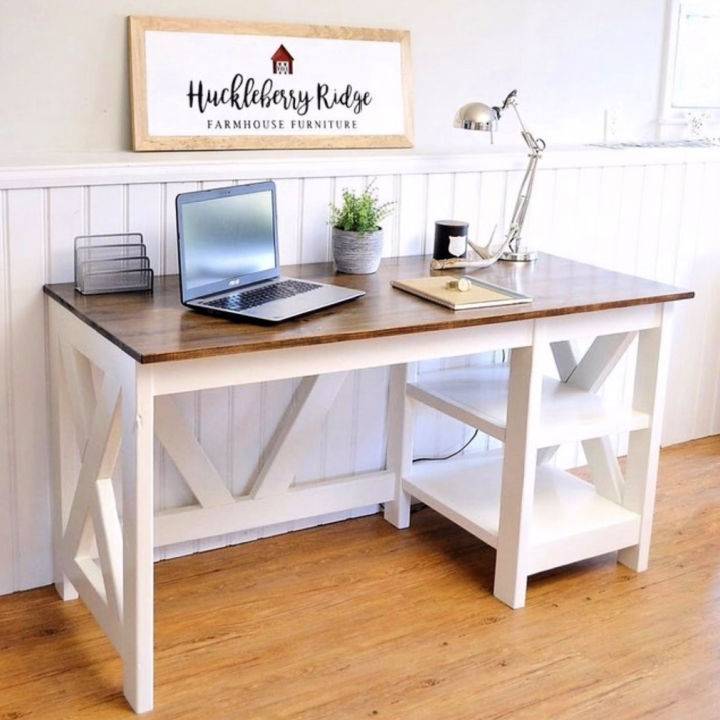
Revamp your work area with a charming DIY Farmhouse X office desk that combines functionality with rustic appeal. Perfectly suited for a modern home office, this desk offers not only a spacious worktop but also includes decorative details that can transform any space.
Courtesy of the collaboration between Ashley from Handmade Haven and Michael and Sara from Huckle Berry Ridge Furniture, this guide walks you through each step of making your very own farmhouse office desk. From selecting materials to assembling the desk, this tutorial is designed to help you achieve a beautiful, handcrafted piece that you'll be proud to show off.
7. Easy DIY A Frame Plywood Desk
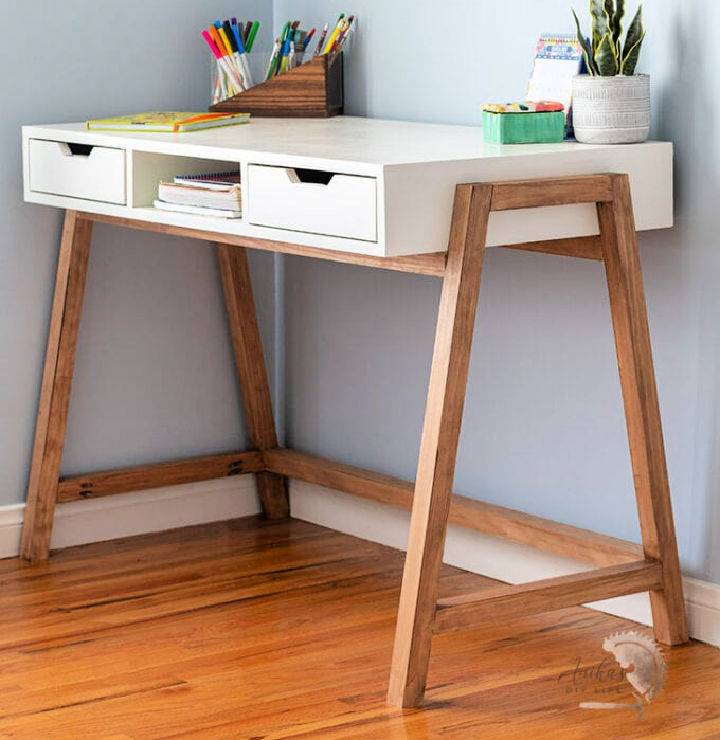
Construct a stylish and functional DIY A-frame desk for your home office following the easy-to-understand DIY tutorial and video provided by Anika at Anika's DIY Life. Perfect for anyone wanting to add a personalized touch to their space, this project only requires four power tools and some basic materials.
Whether decorating a room on a budget or looking for a meaningful gift idea, this desk design is both affordable and elegant. Get detailed plans, a step-by-step guide, and more project ideas to enhance your desk setup. Happy building!
8. Build a Plywood Desktop with Hairpin Leg
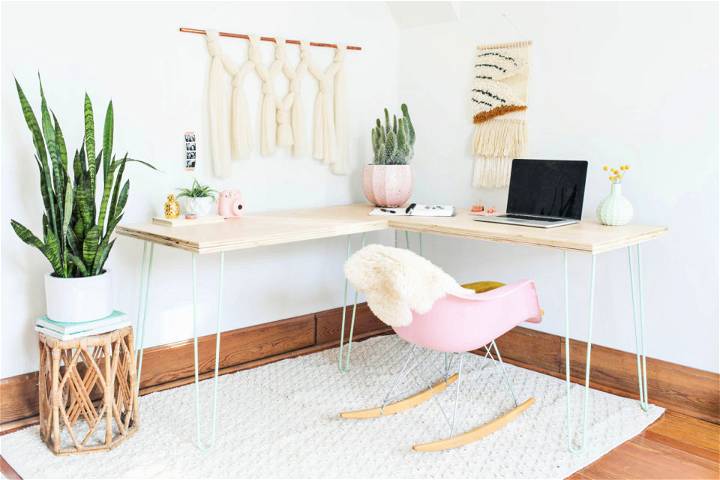
Learn how to build a versatile and stylish hairpin leg desktop that adapts to your changing needs with this step-by-step DIY guide at A Beautiful Mess. Ideal for anyone looking to maximize their workspace in a multifunctional room, this DIY project is not only practical but also introduces a touch of elegance with powder-coated hairpin legs.
Perfect for making more table space or adjusting your setup for different tasks, this transformable desktop is simple enough to build without an extensive collection of power tools. Follow along to craft a solution that looks great and fulfills your dynamic needs.
9. Homemade Plywood Desk with Drawers
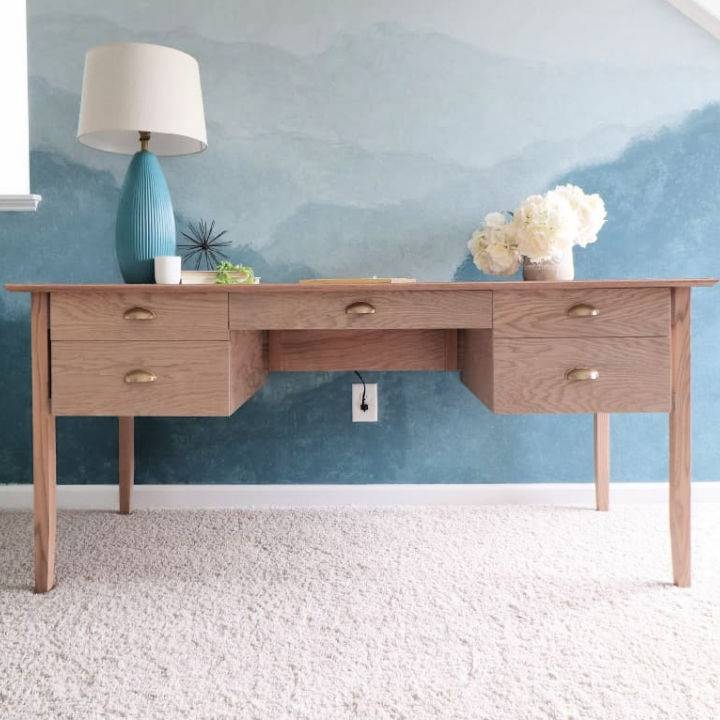
Elevate the look of your workspace with a DIY plywood desk with drawers that combine functionality and style. Ideal for those seeking ample working space, this desk features a large top perfect for multiple monitors, extensive storage options including a convenient file cabinet drawer, and a hidden cord management system.
With its beautiful oak finish and mid-century design, it's a timeless piece that suits any interior. Build it yourself with guidance from Pine and Poplar. This project not only offers practical benefits but also the satisfaction of making a customized workspace tailored to your needs.
10. DIY Plywood Desk with Pipe Frame
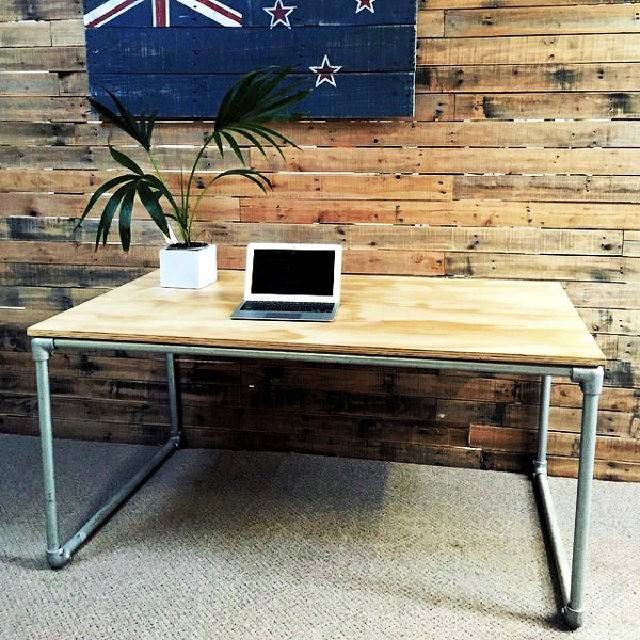
Discover how to easily construct a distinctive DIY plywood desk with a sleek pipe frame, designed for both functionality and style, even if you're not a seasoned builder. With a step-by-step guide found on Simplified Building, this project is accessible for all skill levels. You'll only need basic materials like plywood, Kee Klamp fittings, pipes, and an Allen wrench.
Whether you're seeking to customize your workspace or add a personal touch to your home office, this guide walks you through making a durable and aesthetically pleasing desk. Explore the process and gather inspiration to kickstart your DIY endeavor today.
11. Making a Plywood Double Desk Ikea Hacks
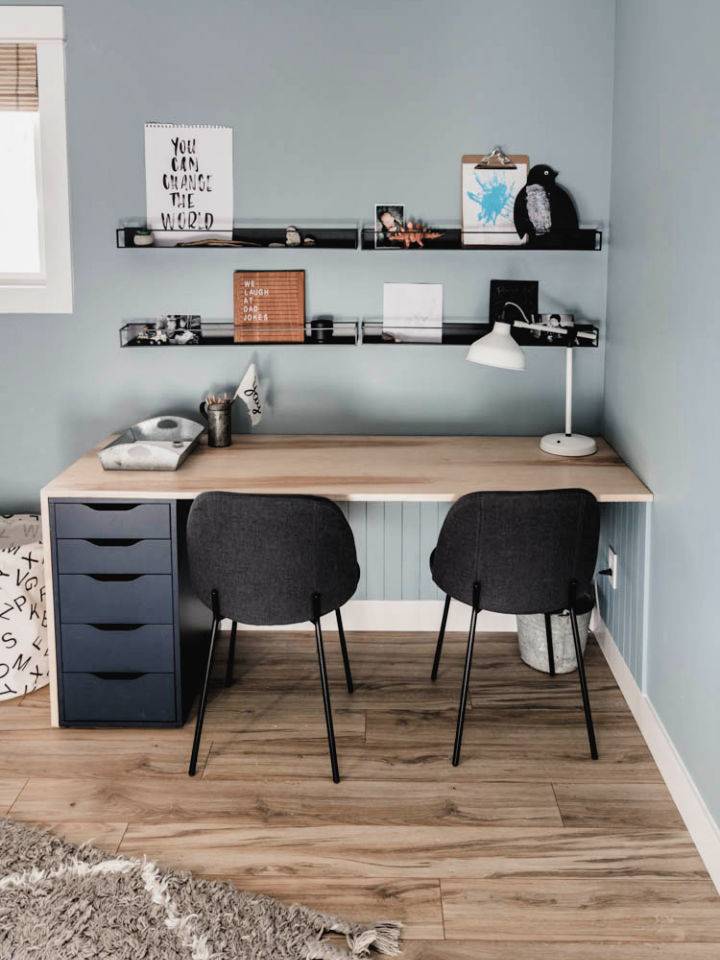
Update your shared kids' space with a stylish and functional plywood DIY double desk, an innovative IKEA hack showcased on Lemon Thistle. This modern desk combines the simplicity of IKEA Alex Drawers with the elegance of maple plywood.
It not only provides enough space for two but also features a chic waterfall edge and an understated shiplap design. Ideal for room makeovers, this desk is a testament to style meeting practicality, ensuring a clutter-free and cohesive workspace for kids. Follow a straightforward guide to remake this masterpiece in your home.
12. Affordable Handmade Plywood Desk
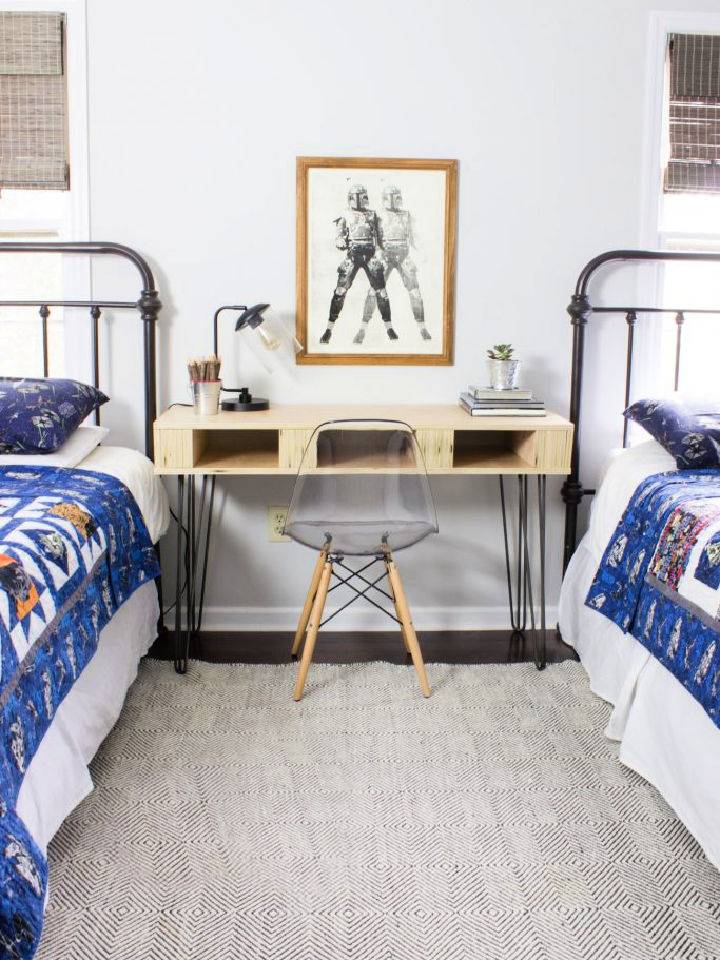
Start building your own DIY plywood desk with guidance from Erin Spain's straightforward and engaging tutorial. Ideal for those dipping their toes into the world of DIY, this project is simple yet rewarding, offering room for personalization through paint or stain choices.
From detailed step-by-step instructions to a list of necessary materials, Spain's guide ensures your crafting experience is as smooth as possible, despite life's little distractions, like busy toddlers with boundless energy. Discover how to make a sturdy, stylish workspace that adds character to any room by visiting Erin Spain's website.
13. How to Make a Plywood Desk at Home
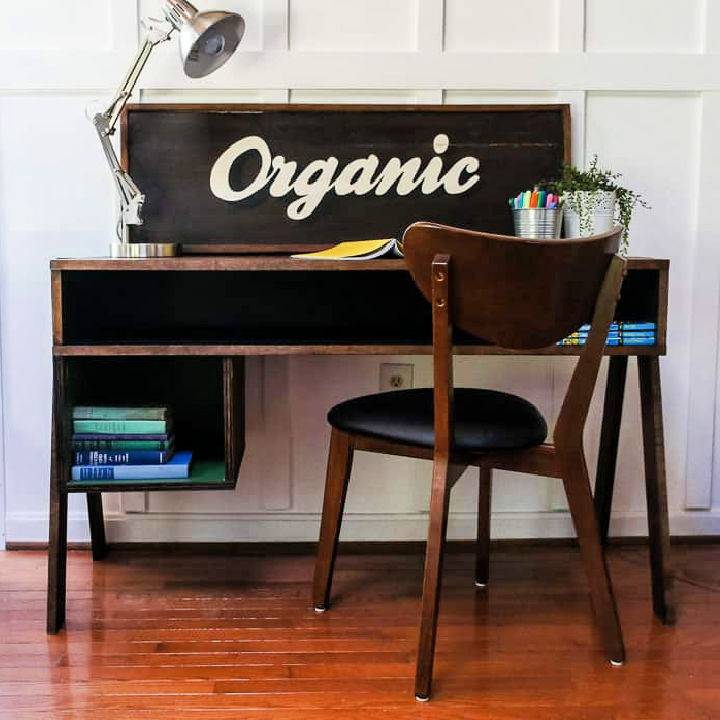
Learn how to build a sleek, simple desk with a midcentury vibe using just one sheet of plywood on Semigloss Design. This DIY tutorial breaks down making a practical desk with storage cubbies, inspired by a vintage design.
Get ready to transform a single plywood sheet into a stylish, functional furniture piece for your home, complete with easy-to-follow steps and a list of necessary supplies. Perfect for adding that personal touch to your office or study area!
14. Beginner-Friendly DIY Plywood Desk
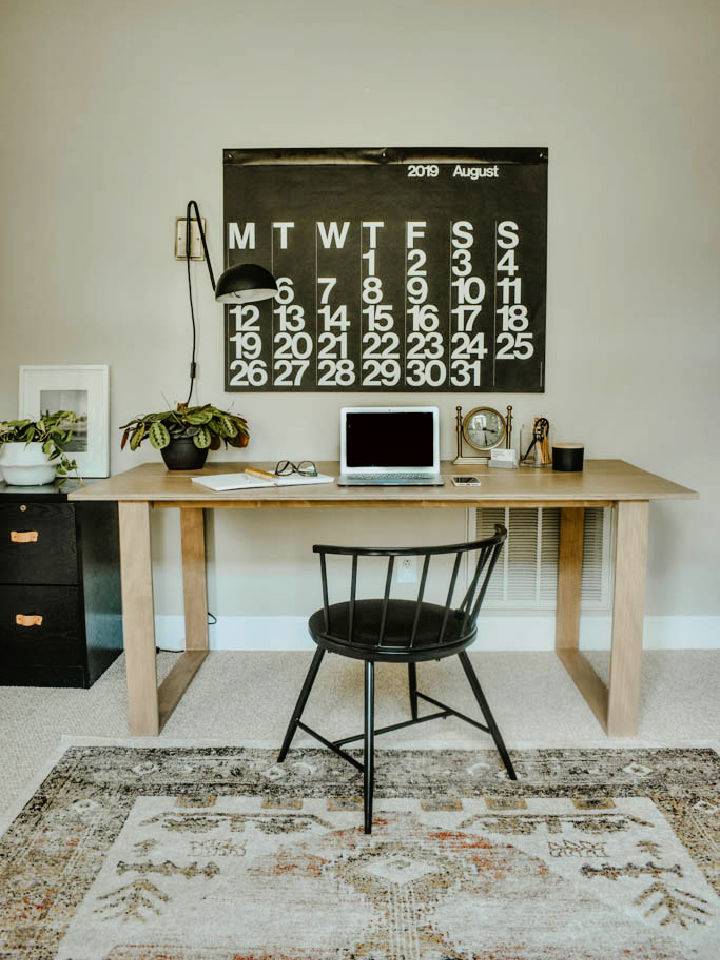
Uplift your workspace with this DIY modern wood desk guide from House On Longwood Lane. With its modern, sleek design, this desk is perfect for those needing an ample workspace for remote learning or home offices.
The tutorial is straightforward, making it a great project for DIY enthusiasts. Say goodbye to wobbly and uninspiring desks with this sturdy, chic, and functional design. Follow these easy steps and make a striking impact in your home today!
15. Build a Mid-Century Plywood Desk Under $100
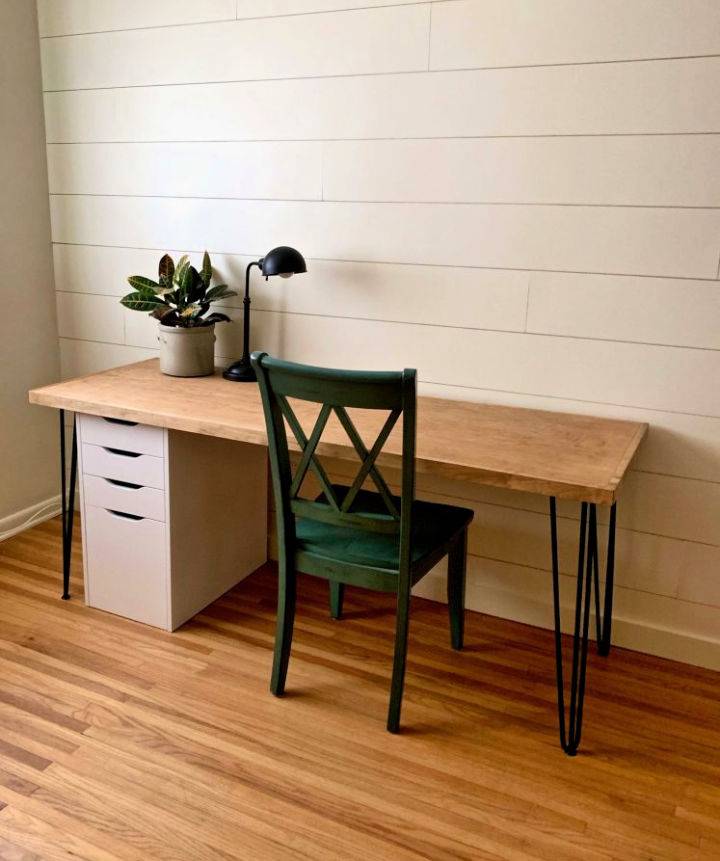
Build your own stunning Mid-Century modern desk for around $100 with this guide from Cedar & Stone Farmhouse. Perfect for those who appreciate design on a budget, this tutorial outlines how to construct a sleek, functional desk that won't break the bank. With detailed steps and a comprehensive list of materials and tools, you're set to make a workspace that's both stylish and practical. The process is manageable for DIY enthusiasts of all levels, promising a rewarding outcome—a chic desk that enhances any room.
Conclusion:
Crafting a DIY plywood desk is not just a rewarding project, but also a fantastic opportunity to customize your workspace to your exact needs and aesthetics. From selecting the right type of plywood and ensuring you have the basic power tools, to adding personalized finishes and addressing common issues like warping or squeaks, each step of this process enriches your DIY experience. We've covered essential tips on material selection, customization ideas, tool safety, and even shared insights on budgeting and the environmental impact of using plywood.
Whether it's making this project your own with decorative touches or keeping your desk in top condition with our maintenance tips, you now have all the knowledge at your fingertips. Remember to check out the video tutorial for visual guidance. Dive into your DIY plywood desk project today and make a space that inspires productivity and creativity.